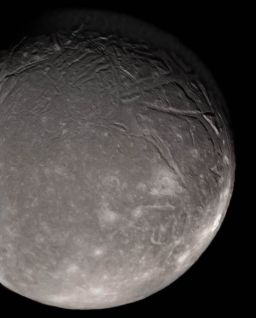Emily Lakdawalla • Mar 13, 2008
Ted Stryk: Revealing the night sides of Uranus' moons
Ted Stryk, who has been contributing guest blogs on the Lunar and Planetary Science Conference, filed this report on the poster he presented this afternoon at the meeting. His abstract (PDF format) contains more details on his processing methods. --ESL
In January of 1986, Voyager 2 zipped through the Uranian system, snapping as many photos as it could. As its trajectory was constrained by the need to continue on to Neptune, tiny Miranda, innermost of the moons known prior to Voyager, was the only moon eligible for a close flyby. Since Uranus is tilted on its side and was near summer solstice in the southern hemisphere at the time of Voyager's flyby, coverage of the planet and its moons rotated around like a spinning top viewed from above until shortly before the closest approach, at which time the angle changed, giving a vantage point looking down at the equatorial regions, with both the illuminated southern hemisphere and the darkness-enshrouded northern hemisphere presenting themselves to Voyager's cameras.
Of course, since the northern hemisphere of the planet and its moons were in the midst of a decades-long night, mentioning that they were in the spacecraft's field of view is pure trivia, since they could not be seen....or so we thought. Several years ago, Phil Stooke of the University of Western Ontario presented a paper showing that the regions beyond the day/night boundary could be faintly seen on the Uranus-facing hemisphere of the moon Ariel (the Uranian moons are tidally locked, meaning that the same face always points toward the planet, which is also why we can only see one face of our Moon, which is also tidally locked), thanks to light reflected off the planet (again, you can see a similar effect when looking at our Moon in its crescent phase, as the unlit regions can be faintly seen due to light reflected off of Earth). The purpose of Stooke's paper was to show the potential for mining hidden information from Voyager data, so he didn't delve deeply into analyzing what could be seen in individual images.
I reprocessed Voyager's best view of Ariel, a 2x2 mosaic of frames taken at a resolution of roughly 2.4 kilometers per pixel near closest approach. The terminator images were somewhat smeared, so the first order of business, after extensive calibration procedures to eliminate instrument noise, was to apply desmearing algorithms to the smeared images. I then applied extensive processing to enhance the poorly illuminated regions (I later duplicated this without desmearing the images to make sure that the features seen were not artifacts induced by this method).
Additionally, an oval-shaped tectonic feature can be seen surrounding Kachina. Since Kachina cross-cuts it, meaning that it passes across these features uninterrupted, the oval-shaped feature must be older. It is possible that this is a large impact basin that has been modified and stretched by later geologic activity (alternatively, it may be a very old, broken-down feature that is missing one of its walls (or the wall is too degraded to show up in imagery of this quality). This oval-shaped tectonic feature, as well as the Kachina extension, were seen as foreshortened features on the limb of a more distant Voyager mosaic I reprocessed, demonstrating them to be real and not simply enhanced instrument noise.
While the quality of the reflected light images is far below the quality of imagery we have for the sunlit sides of these moons, and all of Voyager's coverage pales in comparison to what we are seeing in the Saturnian system thanks to the Cassini mission, Voyager 2 is the only spacecraft to have visited Uranus, and no new missions are in the works. The Uranian system is so distant that not even the Hubble Space Telescope can resolve features on the planet's moons. Thus, although Uranus passed through equinox in December 2007, bringing the northern hemispheres of the planet fully into the light, pulling out new detail in old data provides our only opportunity to get a peek at what lurks in the in the unmapped regions of its fascinating moons.
Support our core enterprises
Your support powers our mission to explore worlds, find life, and defend Earth. You make all the difference when you make a gift. Give today!
Donate

 Explore Worlds
Explore Worlds Find Life
Find Life Defend Earth
Defend Earth





